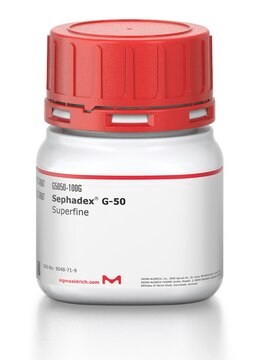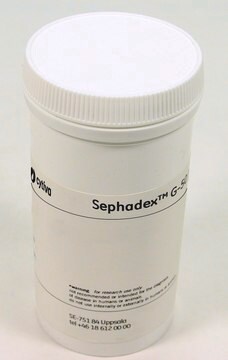S6022
Sephadex® G-50
BioReagent, DNA grade, for molecular biology, medium
About This Item
Prodotti consigliati
Grado
Molecular Biology
for molecular biology
Nome Commerciale
BioReagent
Stato
beads
Rigonfiamento
1 g swells to 9-11 mL
Diametro delle microsfere
50-150 μm
Dimensione pori
exclusion limit (20 bp dsDNA; (rA)20)
pH
2-10
Attività estranea
DNase, RNase, none detected
Temperatura di conservazione
room temp
Stringa SMILE
O1C(C(C(C(C1CO)O)O)O)OCC2OC(C(C(C2O)O)O)OCC(O)C(O)C(O)C(O)C=O
InChI
1S/C18H32O16/c19-1-5(21)9(23)10(24)6(22)3-31-17-16(30)14(28)12(26)8(34-17)4-32-18-15(29)13(27)11(25)7(2-20)33-18/h1,5-18,20-30H,2-4H2
FZWBNHMXJMCXLU-UHFFFAOYSA-N
Cerchi prodotti simili? Visita Guida al confronto tra prodotti
Descrizione generale
Applicazioni
Caratteristiche e vantaggi
- Excellent recovery
- Minimal sample dilution
- Quick and easy to use
Note legali
Prodotti correlati
Codice della classe di stoccaggio
11 - Combustible Solids
Classe di pericolosità dell'acqua (WGK)
WGK 3
Punto d’infiammabilità (°F)
Not applicable
Punto d’infiammabilità (°C)
Not applicable
Dispositivi di protezione individuale
Eyeshields, Gloves, type N95 (US)
Scegli una delle versioni più recenti:
Possiedi già questo prodotto?
I documenti relativi ai prodotti acquistati recentemente sono disponibili nell’Archivio dei documenti.
I clienti hanno visto anche
Il team dei nostri ricercatori vanta grande esperienza in tutte le aree della ricerca quali Life Science, scienza dei materiali, sintesi chimica, cromatografia, discipline analitiche, ecc..
Contatta l'Assistenza Tecnica.











